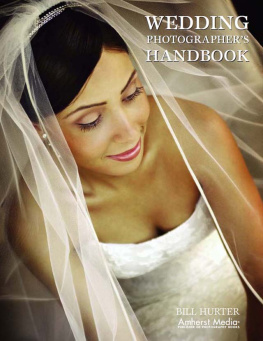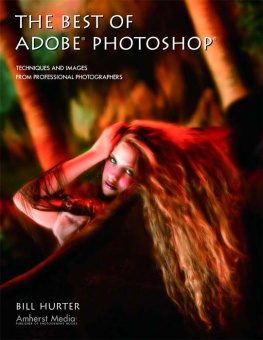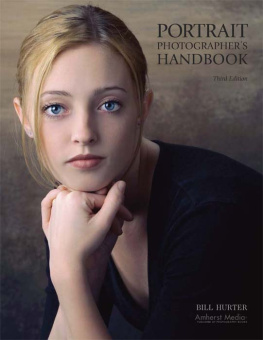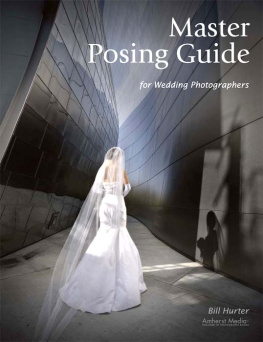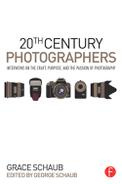
About the Author
Bill Hurter started out in photography in Washington, DC, where he was a news photographer. He even covered the political sceneincluding the Watergate hearings. After graduating with a BA in literature from American University, he completed training at the Brooks Institute of Photography. Going on to work at Petersens PhotoGraphic magazine, he held practically every job except art director. He has been the owner of his own creative agency, shot stock, and worked assignments (including two and a half years with the L.A. Dodgers). He has been directly involved in photography for the last three decades and has seen the revolution in technology. In 1988, Bill was awarded an honorary Masters of Science degree from the Brooks Institute of Photography. In 2007, he was awarded an honorary Masters of Fine Arts degree from Brooks; in 2009, he was awarded WPPIs prestigious Lifetime Achievement award. He has written over 50 books for professional photographers and is most recently the editor-in-chief of Rangefinder and AfterCapture magazines.
Copyright 2015 by Bill Hurter.
All rights reserved.
Photographs in each chapter by the respective featured photographer, unless otherwise noted.
Front cover photograph by: Jose Villa.
Title page photograph by: Scott Robert Lim.
Back cover photographs by: Jonas Peterson (top) and Paul Ernest (bottom).
Published by:
Amherst Media, Inc.
P.O. Box 586
Buffalo, N.Y. 14226
Fax: 716-874-4508
www.AmherstMedia.com
Publisher: Craig Alesse
Associate Publisher: Kate Neaverth
Senior Editor/Production Manager: Michelle Perkins
Associate Editor: Barbara A. Lynch-Johnt
Associate Editors: Beth Alesse, Harvey Goldstein
Editorial Assistance from: Sally Jarzab, John S. Loder, Carey Miller
Business Manager: Adam Richards
Warehouse and Fulfillment Manager: Roger Singo
ISBN-13: 978-1-60895-856-6
Library of Congress Control Number: 2014955643
10 9 8 7 6 5 4 3 2 1
No part of this publication may be reproduced, stored, or transmitted in any form or by any means, electronic, mechanical, photocopied, recorded or otherwise, without prior written consent from the publisher.
Notice of Disclaimer: The information contained in this book is based on the authors experience and opinions. The author and publisher will not be held liable for the use or misuse of the information in this book.
Check out Amherst Medias blogs at: http://portrait-photographer.blogspot.com/
http://weddingphotographer-amherstmedia.blogspot.com/
Contents










T he face of wedding photography has changed drastically over the last few years. Some couples seem now to be content with wedding-day selfies and a collection of cell phone images taken by guests and friends. Because these pictures get posted online, there is no need for an album. For these couples, gone are the storytelling aspects of the wedding coverage that used to be the mainstay of the wedding albumas well as any remnants of the formal wedding coverage that was so popular for so many years.
Yet, while the role of the professional wedding photographer has diminished and full-service wedding jobs are fewer and farther in-between, there continue to emerge great photographers for whom the publics changing tastes have not seemed to make a difference. This group of wedding photographers is doing well both financially and professionally. They are in demand with todays brides. That is where this book finds relevance. It is a ten best collection of these gifted contemporary photographers and a portfolio review of their work. Moreover, it is a review of their success in a difficult environment and a look at their ability to flourish when so many of their counterparts have failed to find lasting success in this challenging marketplace.
Choosing the Photographers
You might ask why these photographers made the list and not ten others. Using my past experience as editor-in-chief of Rangefinder and AfterCapture magazines and one of the architects of the WPPI Print Competition, I set out looking for photographers who were becoming well known because of their style. To put it another way: their success was directly related to the differences they posed with their competition. In more than one way, these people were unique and being well rewarded for their uniqueness.
Another reason I chose these photographers is their diversity. They represent a composite of the best wedding photography today. Their work ranges from the pure editorial/fine-art images of Dan ODay to the highly stylized, romantic reality of Paul Ernest. As styles evolve, we look at cultures where change comes slowly, and thus I have included the work of MRK Palash of Bangladesh, where just making photographs outdoors was a major achievement for his studio. And then there are the purely brilliant photographers like Morgan Lynn Razi, and stylized, on-location lighting gurus Danny and Julia Dong and Dave and Quin Cheung. And then there is the sublime elegance of Jose Villas fashion-inspired work and the visual dexterity of Scott Robert Lim and Roberto Valenzuela. Last but not least is Australian Jonas Peterson, who brings a special extravagance to the group. I am fond of all ten and their work and I love the fact that each of these photographers represents a different art form and a uniquely different style.
Next page


